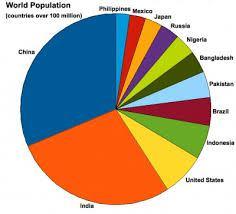GR: This video (https://youtu.be/zEO8p5BudUc) has a great discussion of the current and future human population. Population growth is ruining the Earth. Learn why and what you can do about it in this video. (You can review United Nations’ interactive population charts here.) Recommended.
“World population size increased at a slow and uneven pace for centuries before the onset of the Industrial Revolution, and did not reach 1 billion until about 1800. The modern expansion of human numbers started then, but its pace was still modest for the next 150 years with the world total rising to 2.5 billion in 1950. During the second half of the 20th century, however, population growth rates accelerated to historically unprecedented levels, especially in Africa, Asia, and Latin America. As a result, world population size nearly tripled to 7.3 billion by 2015. This ongoing population expansion is expected to continue for several more decades reaching 11.2 billion at the end of this century. The future addition of four billion more people to the planet will have wide-ranging and potentially adverse implications for human welfare and the natural environment.

I. Population trends
Population size
“Long-range trends in population size typically show a logistic pattern. For much of human history, population growth was absent or very slow. In the more recent past, waves of countries have gone through socio-economic and demographic transitions. Countries’ population growth rates first accelerated, then declined, until population size leveled off at its likely maximum. This process is referred to as the demographic transition which usually takes place over the course of a century or more and is accompanied by a development process that transforms agricultural societies into industrial ones. Before the transition’s onset, population growth fluctuated near zero as high birth rates more or less offset the high death rates typical of traditional agrarian societies that preceded the industrial revolution. After the completion of the transition, population growth was again near zero as birth and death rates both reached low levels. During the intervening transition period, population growth was positive as the death rate dropped before the birth rate. Over the course of the transition, population size of countries multiplied many times.
“The first demographic transitions began in the early 19th century with declines in death rates in the now economically developed parts of the world (e.g., Europe, North America). Large declines in birth rates followed in the late 19th and early part of the 20th century. The transitions in these countries are now more or less complete.”
. . . .
The multi-sectoral impacts of family planning
When couples implement their own decisions about family size, their actions lead to a range benefits:
- Women’s empowerment: Women have greater freedom to determine the number and spacing of children and have more freedom to participate in the formal labor force and civic life;
- Health: The reduction in unintended pregnancies and the wider spacing of pregnancies reduce maternal mortality and morbidity and improve infant and child survival and health;
- Economy: A decline in unplanned births reduces the ratio of dependents to workers, raises investment in human capital, and leads to greater participation of women in the formal labor force. These trends are the cause of the demographic dividend (discussed earlier) which boosts GDP per capita and helps developing countries to accelerate poverty reduction;
- Government: Less pressure on education and health care sectors and on the country’s infrastructure (e.g. transportation, communication, energy, water and sanitation);
- Environment: Reduced pressure on natural resources on which peoples’ lives depend (fresh water, soil, forest, agriculture, energy, etc.) and reduces air, water, and soil pollution; and
- Social/Political stability: With a slower-growing youth population there is less competition for jobs and fewer unemployed youth, thus making political environments more stable.
Conclusion
Assisting couples to achieve their reproductive preferences is a compassionate act that promotes responsible parenthood and improves the lives of women, their children, and their communities, especially among the poor and most vulnerable sections of societies. The resulting decline in unplanned births also enhances prospects for poverty reduction and moderates the increasingly harmful impact of human activities on the natural environment.” –John Bongaarts (Continue reading: Population: Current State and Future Prospects.)

